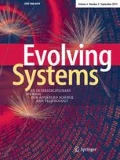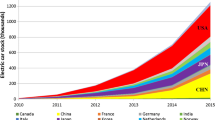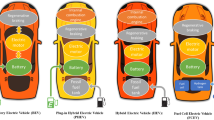Abstract
Electric mobility has gained much interest in the automotive industry and among commercial customers. A well-developed charging infrastructure is a fundamental requirement to meet the rising demand for electricity. The aim of this contribution is to demonstrate how optimization can be used for the extension of public charging infrastructure for electric vehicles (EVs). The suitability of conversion from combustion engines to EVs for commercial customers is evaluated for different scenarios. The impact of an expanded charging infrastructure is measured by a multi-objective genetic algorithm. The location and type of charging stations is optimized with respect to the number of failed trips, due to empty batteries, and the total cost of infrastructure. Assuming that the usage of commercial vehicles ist unaltered when switching to EVs, travel data from commercial vehicles with combustion engines may serve as a starting point for the optimization of the charging infrastructure. The resulting pareto front may support decision makers in placing optimal public charging stations.


















Similar content being viewed by others
References
Angelov P (1994) A generalized approach to fuzzy optimization. Int J Intell Syst 9(3):261–268
Angelov P (2014) Outside the box: an alternative data analytics framework. J Autom Mobile Robot Intell Syst 8(2):29–35
Angelov P, Kasabov N (2005) Evolving computational intelligence systems. In: Proceedings of the 1st international workshop on genetic fuzzy systems, pp 76–82
Baruah RD, Angelov P (2013) Dec: dynamically evolving clustering and its application to structure identification of evolving fuzzy models. IEEE Trans Cybern 44(9):1619–1631
Carvalho AG, Araújo AFR (2013) Improving NSGA-II with an adaptive mutation operator. CoRR, vol. arXiv:1305.4947
Chen TD, Kockelman KM, Khan M (2013) Locating electric vehicle charging stations: parking-based assignment method for seattle, Washington. Transp Res Rec 2385(1):28–36
ConnectFleet (2019) Volkswagen commercial vehicles. https://www.volkswagen-nutzfahrzeuge.de/de/vernetzte-mobilitaet/we-connect-fleet.html. Accessed 18 July 2019
Deb K, Pratap A, Agarwal S, Meyarivan T (2002) A fast and elitist multiobjective genetic algorithm: NSGA-II. IEEE Trans Evol Comput 6(2):182–197
Dong J, Liu C, Lin Z (2014) Charging infrastructure planning for promoting battery electric vehicles: an activity-based approach using multiday travel data. Transp Res Part C Emerg Technol 38(Supplement C):44–55
Efthymiou D, Chrysostomou K, Morfoulaki M, Aifantopoulou G (2017) Electric vehicles charging infrastructure location: a genetic algorithm approach. Eur Transp Res Rev 9(2):27. https://doi.org/10.1007/s12544-017-0239-7
Ende Dvd, Thiery J-M, Eisemann E (2015) Accelerated mean shift for static and streaming environments. In: Data analytics 2015, the fourth international conference on data analytics, vol 4, pp 140–145. https://www.thinkmind.org/index.php?view=instance&instance=DATA+ANALYTICS+2015
Ester M, Kriegel H-P, Sander J, Xu X (1996) A density-based algorithm for discovering clusters a density-based algorithm for discovering clusters in large spatial databases with noise. In: Proceedings of the second international conference on knowledge discovery and data mining, ser. KDD’96. AAAI Press, pp 226–231. http://dl.acm.org/citation.cfm?id=3001460.3001507. Accessed 23 Apr 2018
Faberi S, Paolucci L, Lapillonne B, Pollier K (2012) Trends and policies for energy savingsand emissions in transport. ODYSSEE-MURE 2012. http://www.odyssee-mure.eu/publications/br/energy-efficiency-trends-policies-transport.pdf. Accessed 23 Apr 2018
Feng W, Figliozzi MA (2012) Conventional vs electric commercial vehicle fleets: a case study of economic and technological factors affecting the competitiveness of electric commercial vehicles in the USA. Procedia Soc Behav Sci 39(Supplement C):702–711 (seventh international conference on city logistics which was held on June 7–9 2011. Mallorca, Spain)
Fortin F-A, De Rainville F-M, Gardner M-A, Parizeau M, Gagné C (2012) DEAP: evolutionary algorithms made easy. J Mach Learn Res 13:2171–2175
Garen J (2005) Mehrzieloptimierung betriebswirtschaftlicher Probleme durch evolutionäre Algorithmen. Lang
Gkatzoflias D, Drossinos Y, Zubaryeva A, Zambelli P, Dilara P, Thiel C (2016) Optimal allocation of electric vehicle charging infrastructure in cities and regions. EUR—scientific and technical research reports
Hong S, Kuby M (2016) A threshold covering flow-based location model to build a critical mass of alternative-fuel stations. J Transp Geogr 56(Supplement C):128–137
Hosseini M, MirHassani SA, Hooshmand F (2017) Deviation-flow refueling location problem with capacitated facilities: model and algorithm. Transp Res Part D Transp Environ 54(Supplement C):269–281
Kim J-G, Kuby M (2012) The deviation-flow refueling location model for optimizing a network of refueling stations. Int J Hydrog Energy 37(6):5406–5420 (optimization approaches to hydrogen logistics)
Krallmann T, Doering M, Stess M, Graen T, Nolting M (2018) Multi-objective optimization of charging infrastructure to improve suitability of commercial drivers for electric vehicles using real travel data. In: 2018 IEEE conference on evolving and adaptive intelligent systems (EAIS). IEEE, pp 1–8
Kuby M, Lim S (2005) The flow-refueling location problem for alternative-fuel vehicles. Socio-Econ Plan Sci 39(2):125–145
Nationale Plattform Elektromobilität (2013) Technischer Leitfaden Ladeinfrastruktur
Nationale Plattform Elektromobilität (2015) Ladeinfrastruktur für Elektrofahrzeuge in Deutschland, Statusbericht und Handlungsempfehlungen 2015
Open Charge Map (2017) Open Charge Map—the global public registry of electric vehicle charging locations. https://openchargemap.org/. Accessed 30 Nov 2017
Rechenberg I (1973) Evolutionsstrategie: Optimierung technischer Systeme nach Prinzipien der biologischen Evolution, ser. Problemata, 15.Frommann-Holzboog
Shi R, Lee KY (2015) Multi-objective optimization of electric vehicle fast charging stations with spea-ii. IFAC-PapersOnLine 48(30):535–540 (9th IFAC symposium on control of power and energy systems CPES 2015)
Soylu T, Anderson JE, Böttcher N, Weiß C, Chlond B, Kuhnimhof T (2016) Building up demand-oriented charging infrastructure for electric vehicles in Germany. Transp Res Procedia 19(Supplement C):187–198 (transforming urban mobility. mobil.TUM 2016. International scientific conference on mobility and transport. Conference Proceedings)
Studie e-Crafter (2017) Volkswagen commercial vehicles. https://www.volkswagen-nutzfahrzeuge.de/content/vw_nfz/magazine/de/de/eCrafter.html. Accessed 23 Apr 2018
Xie F, Liu C, Li S, Lin Z, Huang Y (2018) Long-term strategic planning of inter-city fast charging infrastructure for battery electric vehicles. Transp Res Part E Logist Transp Rev 109:261–276
Zhu Z-H, Gao Z-Y, Zheng J-F, Du H-M (2016) Charging station location problem of plug-in electric vehicles. J Transp Geogr 52(Supplement C):11–22
Zitzler E, Laumanns M, Thiele L (2001) SPEA2: Improving the strength Pareto evolutionary algorithm. TIK-report, 103. http://citeseerx.ist.psu.edu/viewdoc/summary?doi=10.1.1.22.4617
Acknowledgements
The authors received funding from Volkswagen AG, the company behind the ConnectFleet services and manufacturer of the e-Crafter van.
Funding
This study was funded by Volkswagen AG.
Author information
Authors and Affiliations
Corresponding author
Ethics declarations
Conflict of interest
The authors declare that they have no conflict of interest.
Human/animal right statement
This work does not contain any studies with human participants or animals performed by any of the authors.
Informed consent
Informed consent was obtained from all individual participants included in the study.
Additional information
Publisher's Note
Springer Nature remains neutral with regard to jurisdictional claims in published maps and institutional affiliations.
Rights and permissions
About this article
Cite this article
Zeng, L., Krallmann, T., Fiege, A. et al. Optimization of future charging infrastructure for commercial electric vehicles using a multi-objective genetic algorithm and real travel data. Evolving Systems 11, 241–254 (2020). https://doi.org/10.1007/s12530-019-09295-4
Received:
Accepted:
Published:
Issue Date:
DOI: https://doi.org/10.1007/s12530-019-09295-4




